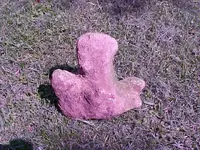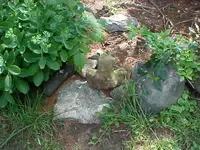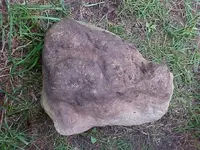Re: JUST A FEW OF MY ARTIFACTS, & Dino Debate
I hope I don't insult anyone but as to Dinosaurs and Man (ie. Homo-sapien) They absolutely did NOT exist at the same time. Jimb you are talking about fake history or Cryptozoology.
Here is a SCIENTIFIC Time Line.
Mesozoic Era - Triassic period
230 Million Years to 195 Million Years ago
Climate warming; semiarid to arid. Continental plates, joined c.200 million years ago in supercontinent Pangaea, begin to break into continents; faults, tilting widespread. Fewer species, higher populations. Ammonites, clams, snails present. First dinosaurs. First mammals may have evolved.
Mesozoic Era - Cretaceous period
140 Million Years to 65 Million Years ago
Extensive submergence of continents leaves overlapping marine rocks. Chalk deposits. South America, Africa separate; North Atlantic widening. Cycles of orogeny. Dinosaurs, large reptiles climax, then disappear. Snakes, lizards, appear. Revolution in plants:flowering plants (angiosperms); modern trees. Floral uniformity that lasts into Eocene.
Some 65 million years ago, a giant asteroid or comet struck the earth, spewing huge amounts of dust and debris into the air. That dust, according to a widely accepted theory first proposed by Nobel laureate Luis Alvarez, was circulated by the winds and enshrouded the earth for months, blocking sunlight and causing temperatures to plummet. As a result, the dinosaurs, and 70% of all other terrestrial species, were wiped out. Kevin Pope, a former NASA scientist, reviewing recent studies of atom-bomb blasts and analyses of particles in strata at the 65 million-year level concluded that most of the dust particles were too large to have remained suspended in the air for many months. Pope speculates instead that soot from the worldwide conflagrations, sulfate aerosols and other impact phenomena were to blame.
2 Million Years Ago
Stone Age, period beginning with the earliest human development, c.2 million years ago. It is divided into three periods. The Paleolithic period, or Old Stone Age, was the longest phase of human history, roughly coextensive with the Pleistocene Epoch. Its most outstanding feature was the development of Homo sapiens. Paleolithic peoples were generally nomadic hunters and gatherers who sheltered in caves, used fire, and fashioned stone tools. Their cultures are identified by distinctive stone-tool industries: Pre-Chellean, Abbevillian (or Chellean), and Acheulian in the Lower Paleolithic; Mousterian in the Middle Paleolithic, associated with Neanderthal man; and Aurignacian, Solutrean, and Magdalenian in the Upper Paleolithic. By the Upper Paleolithic there is evidence of communal hunting, constructed shelters, and belief systems centering on magic and the supernatural. Rock carvings and paintings reached their peak in the Magdalenian culture of Cro-Magnon man. The Mesolithic period, or Middle Stone Age, began at the end of the last glacial era, over 10,000 years ago. Cultures included gradual domestication of plants and animals, formation of settled communities, use of the bow, and development of delicate stone microliths and pottery. Notable Mesolithic cultures were the early Azilian and Tardenoisian, over most of Europe; the middle Mesolithic Maglemosian, in the Baltic and N England; the late Ertebolle, or kitchen-midden culture; and the Natufiar, in the Middle East. The time periods and cultural content of the Neolithic period, or New Stone Age, vary with geographic location. The earliest known Neolithic culture developed from the Natufian in SW Asia between 8000 and 6000 B.C. People lived in settled villages, cultivated grains and domesticated animals, developed pottery and weaving, and evolved into the urban civilizations of the Bronze Age. In SE Asia a distinct type of Neolithic culture cultivated rice before 2000 B.C. New World peoples independently domesticated plants and animals, and by 1500 B.C. Neolithic cultures existed in Mexico and South America that led to the Aztec and Inca civilizations.
1.75 Million Years ago
Homo erectus our nearest ancestor, appeared in Africa perhaps 1.75 million years ago and began spreading into Asia and Europe soon after. It had a fairly large brain and a skeletal structure similar to ours. The size of its braincase, however, was intermediate between Homo habilis and Homo sapiens. Its culture included stone tools and the first use of fire. The first fossils, found (1891) in Java, were called Pithecanthropus, or Java man. Homo erectus learned to control fire and probably had primitive language skills. The final brain development to Homo sapiens and then to our subspecies Homo sapiens sapiens occurred between 500,000 and 50,000 years ago, either in one place-probably Africa-or virtually simultaneously and independently in different places in Africa, Europe, and Asia. All modern races are unquestionably members of the subspecies Homo sapiens sapiens.
The spread of humankind into the remaining habitable continents probably took place near the end of the last Ice Age: from Asia to the Americas, across a land bridge, and to Australia, across the Timor Straits.
I am sorry for the size but this is a true and accurate timeline of the time between the last dinosaurs and the beginning of man. Not to mention Real proof. For this timeline goto:
http://www.b17.com/family/lwp/chronology/prehistory.html
Respects to all & Good Hunting!
~Z~












 Feel free to quote me on that.
Feel free to quote me on that.